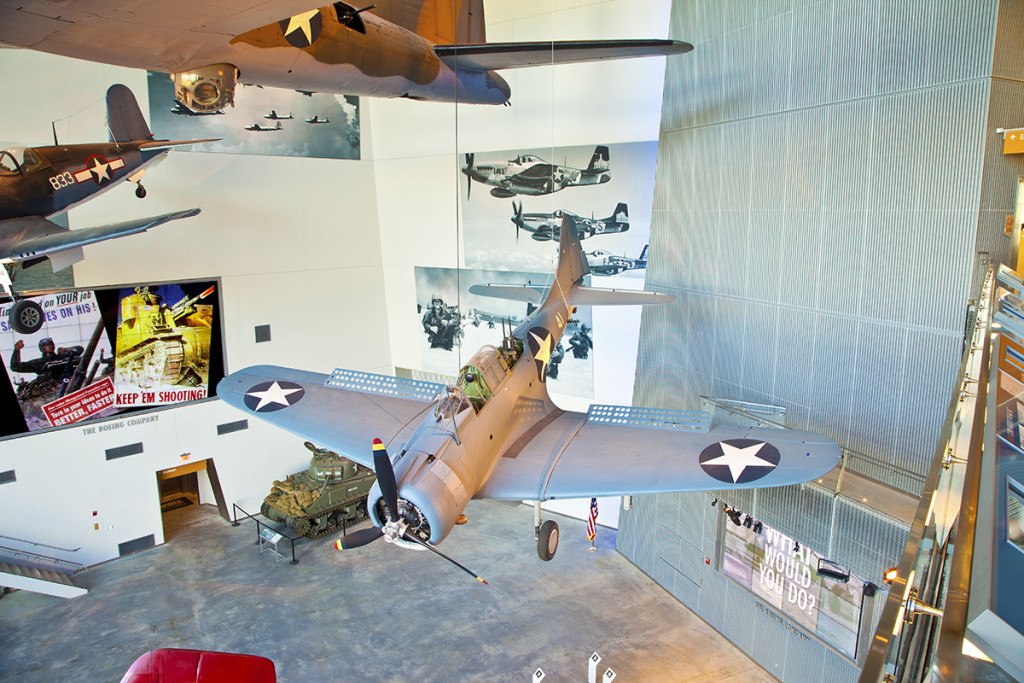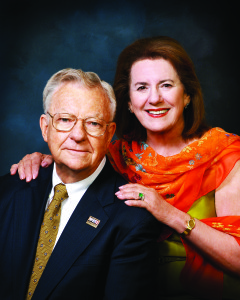Donor Spotlight: Madlyn and Paul Hilliard
The SBD Dauntless warbird in the US Freedom Pavilion: The Boeing Center, has been made possible through a generous gift by Paul and Madlyn Hilliard.
Visitors will recognize the Dauntless by its distinctive perforated flaps, or air brakes. Dive bombing, a popular tactic used on both sides in WWII, required precise maneuverability and accuracy to fly at a steep trajectory and hit a moving target. The Douglas SBD Dauntless was sturdy enough for pilots to dive at a near-vertical 80 degrees. The US Navy’s primary dive-bomber at the war’s start, the bomber earned its reputation — and helped secure victory — at the 1942 Battle of Midway, sinking four Japanese carriers. By most accounts, the Dauntless sank more Japanese ships than any other plane in WWII. More than 6,000 of the SBD models were produced.
SBD-3, Bureau Number (BuNo) 06508, featured in the Museum, was built by Douglas Aircraft Company and served in the Cactus Air Force in the Guadalcanal Campaign, operating from Henderson Field in Marine Scout Bombing Squadrons 141 and 132. In the spring of 1943, BuNo 06508 was assigned to Navy Bombing Squadron 10 aboard the aircraft carrier Enterprise for a short time before being returned to the states to serve as a trainer at Naval Air Station Glenview in Illinois. In November 1944, this aircraft was lost on a training flight in Lake Michigan where it remained until 1990, when it was recovered and restored by the National Museum of Naval Aircraft.
Donor Spotlight: Madlyn and Paul Hilliard
For more than a decade, Museum trustee and WWII veteran Paul Hilliard and his wife, Madlyn, have been two of the Museum’s most active advocates and supporters. They have provided transformative support for several Museum initiatives, including the capital expansion, acquisition and restoration of artifacts, collection of oral histories, and education programs.
Paul is a Marine Corps veteran who served as a radioman/gunner in SBD “Dauntless” dive bombers in the Pacific. He turned 17 in June of 1942 and pleaded with his mother to authorize his enlistment in the Marines, finally, in February of 1943, she relented and Paul was shipped to boot camp in San Diego. After more than a year of training in aviation radio, radar and gunnery, he was sent to the Solomons for assignment to an SBD dive bomber squadron.
In the Philippines the SBDs served as “airborne artillery” for General Krueger’s Sixth Army, assigned to dive bomb and strafe targets assigned by the army units attacking the Japanese on the ground. He flew many “Columbus missions,” named this because “we were unaware where we were going when we took off, we didn’t where we were when arrived at the target and when we returned to base we didn’t know where we had been. We did it all at the government’s expense.”
Paul said that when overseas, he knew little about events in the overall war beyond the view from their tent, their short mission briefings, or the unrecognizable sights from the rear seat of a dive bomber. Aside from that, brief summaries were fed to him about once a week in a crudely mimeographed news letter. He states, “we were mostly teenagers and much of our leisure was spent thinking about food, talking about food or complaining about food. The occasional cans of warm beer were a much-appreciated supplement.”
After being discharged, Paul states that he did not discuss the war for 40 years. He states “to those of us who wore a uniform between 1940 and 1946, it seemed as if nearly every man in America had served and so it was so normal, so commonplace, that the subject seldom surfaced.” He stated that with almost 50% of able-bodied men in the United States in uniform, each played an important role in securing freedom. Paul states that he credits “Stephen Ambrose with reviving the discussion and the interest as his books shed light on specific anecdotes, on small-unit-actions, and on the long-lasting impact the War had and was going to have on world history. Once I began to realize that I had been privileged to play a minor role in an enormous event, I became and still am, an assiduous student of WWII. The National WWII Museum has been and is an incredible opportunity to further my interest and to help tell the story of “the war that changed the world.”
The continuous support of Paul and Madlyn attests to their interest in and commitment to telling the story. Madlyn says, “what is so rewarding about [the Museum], is its growth and the enthusiasm of the young visitors, their amazing knowledge of events in the War and their enjoyment of their visit. It’s contagious!!”
Paul says the Museum “tells the story of America at its best and of not only what Americans did during that War to ensure the freedom of millions around the world but to assure later generations that when fascism tackles freedom, freedom is going to come out on top. And whatever we have done or are doing to assist in spreading and trumpeting that message, is done from a sense of gratitude rather than generosity.”
- Posted :
- Post Category :
- Tags :
- Follow responses to this entry through the RSS 2.0 feed. You can skip to the end and leave a response. Pinging is currently not allowed.






Leave a Reply